

Ludlow Massacre. The Ludlow Massacre was an attack by the Colorado National Guard and Colorado Fuel & Iron Company camp guards on a tent colony of 1,200 striking coal miners and their families at Ludlow, Colorado, on April 20, 1914.
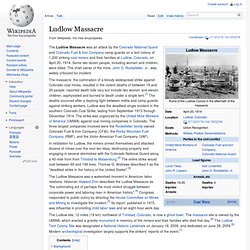
Some two dozen people, including women and children, were killed. The chief owner of the mine, John D. Rockefeller, Jr., was widely criticized for incident. The massacre, the culmination of a bloody widespread strike against Colorado coal mines, resulted in the violent deaths of between 19 and 26 people; reported death tolls vary but include two women and eleven children, asphyxiated and burned to death under a single tent.[1] The deaths occurred after a daylong fight between militia and camp guards against striking workers. Frank Little (unionist) Frank H.
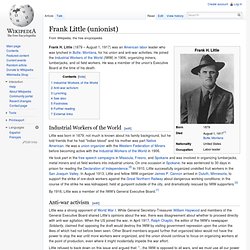
Little (1879 – August 1, 1917) was an American labor leader who was lynched in Butte, Montana, for his union and anti-war activities. Albert Parsons. Biography[edit] Early years[edit] Albert Parsons was born June 20, 1848,[1] in Montgomery, Alabama, one of the ten children of the proprietor of a shoe and leather factory who had originally hailed from Maine.[2] Parsons claimed to be the scion of pioneer English immigrants, with "the first Parsons family" arriving at Narragansett Bay in what is now the state of Rhode Island in 1632.[3] One of the Tompkins on his mother's side was with George Washington in the American Revolution and fought at the Battle of Brandywine.
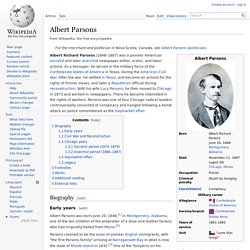
He was also a descendant of Major General Samuel Holden Parsons of Massachusetts, another officer in the Revolution, as well as a Captain Parsons who received wounds at the Battle of Bunker Hill. Civil War and Reconstruction[edit] In this supercharged political atmosphere, Parsons' paper could not long survive and publication was soon terminated.[9] Chicago years[edit] Socialist period (1874–1879)[edit] Steel engraving of Albert R. Haymarket affair. The Haymarket affair (also known as the Haymarket massacre or Haymarket riot) refers to the aftermath of a bombing that took place at a labor demonstration on Tuesday May 4, 1886, at Haymarket Square[2] in Chicago.

It began as a peaceful rally in support of workers striking for an eight-hour day. An unknown person threw a dynamite bomb at police as they acted to disperse the public meeting. French and Indian War. Not to be confused with the French and Indian Wars, the name given to a series of conflicts, which includes the following war.
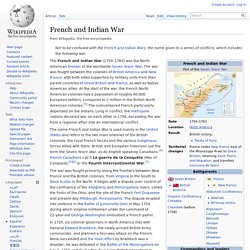
The name French and Indian War is used mainly in the United States and refers to the two main enemies of the British colonists: the royal French forces and the various indigenous forces allied with them. British and European historians use the term the Seven Years' War, as do English speaking Canadians.[4] French Canadians call it La guerre de la Conquête (War of Conquest).[5][6] or the Fourth Intercontinental War.[7]
Algonquin people. Range of Algonquins around year 1800 in green Algonquin family in their tent Though known by several names in the past, the most common term "Algonquin" has been suggested to derive from the Maliseet word elakómkwik (IPA: [ɛlæˈɡomoɡwik]): "they are our relatives/allies".[2][3] The much larger heterogeneous group of Algonquian-speaking peoples, who stretch from Virginia to the Rocky Mountains and north to Hudson Bay, was named after the tribe.
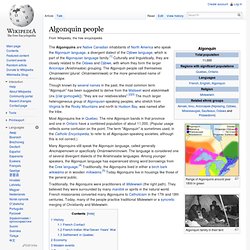
Most Algonquins live in Quebec. Mohawk people. Free Ships Passenger Lists Arriving in the USA 1630-1640. Mali Empire. The Mali Empire (Manding: Nyeni;[4] English: Niani), also historically referred to as the Manden Kurufaba[1] was a Mandinka empire in West Africa from c. 1230 to c. 1600.
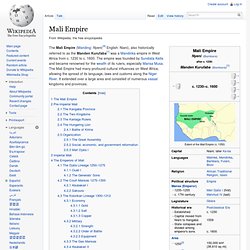
The empire was founded by Sundiata Keita and became renowned for the wealth of its rulers, especially Mansa Musa. The Mali Empire had many profound cultural influences on West Africa, allowing the spread of its language, laws and customs along the Niger River. It extended over a large area and consisted of numerous vassal kingdoms and provinces. History of Sierra Leone. The history of Sierra Leone began when the lands became inhabited at least 2,500 years ago.
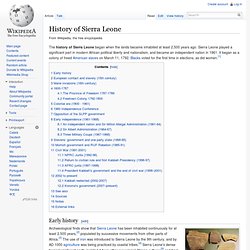
Sierra Leone played a significant part in modern African political liberty and nationalism, and became an independent nation in 1961. It began as a colony of freed American slaves on March 11, 1792, Blacks voted for the first time in elections, as did women.[1] Early history[edit] Archaeological finds show that Sierra Leone has been inhabited continuously for at least 2,500 years,[2] populated by successive movements from other parts of Africa.[3] The use of iron was introduced to Sierra Leone by the 9th century, and by AD 1000 agriculture was being practiced by coastal tribes.[4] Sierra Leone's dense tropical rainforest partly isolated it from other precolonial African cultures[5] and from the spread of Islam.
European contacts with Sierra Leone were among the first in West Africa. Barbot: A Voyage to Congo River. Slaves. Alonso de Sandoval: Seventeenth-Century Merchant of the Gospel, by M.E. Beers. William Byrd II. Colonel William Byrd II (March 28, 1674 – August 26, 1744) was a planter, slave-owner and author from Charles City County, Virginia.
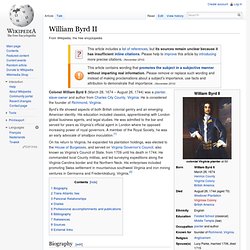
He is considered the founder of Richmond, Virginia. Byrd's life showed aspects of both British colonial gentry and an emerging American identity. His education included classics, apprenticeship with London global business agents, and legal studies. He was admitted to the bar and served for years as Virginia's official agent in London where he opposed increasing power of royal governors. Slave rebellion. A slave rebellion is an armed uprising by slaves.
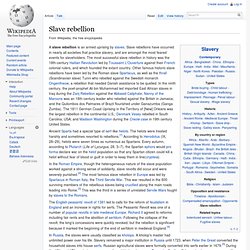
Slave rebellions have occurred in nearly all societies that practice slavery, and are amongst the most feared events for slaveholders. The most successful slave rebellion in history was the 18th-century Haitian Revolution led by Toussaint L'Ouverture against their French colonial rulers, and which founded the extant country. Other famous historic slave rebellions have been led by the Roman slave Spartacus, as well as the thrall (Scandinavian slave) Tunni who rebelled against the Swedish monarch Ongentheow, a rebellion that needed Danish assistance to be quelled. Encyclopedia Virginia: Westmoreland Slave Plot (1687) Background Late in the seventeenth century, Virginia had been the site of a number of planned and actual revolts. On September 13, 1663, a conspiracy in that included African slaves, white indentured servants, and Virginia Indians was betrayed by one of its members. History of Ghana. The Republic of Ghana is named after the medieval West African Ghana Empire.[1] The Empire became known in Europe and Arabia as the Ghana Empire after the title of its emperor, the Ghana.
The Empire appears to have broken up following the 1076 conquest by the Almoravid General Abu-Bakr Ibn-Umar. A reduced kingdom continued to exist after Almoravid rule ended, and the kingdom was later incorporated into subsequent Sahelian empires, such as the Mali Empire several centuries later. Geographically, the ancient Ghana Empire was approximately 500 miles (800 km) north and west of the modern state of Ghana, and controlled territories in the area of the Sénégal River and east towards the Niger rivers, in modern Senegal, Mauritania and Mali.
Ashanti Empire. The Ashanti (or Asante) Empire (or Confederacy), also Asanteman (1701–1957), was a West Africa sovereign state of the ethnic Akan people of Ashanti, Brong-Ahafo, Central region, Eastern region, Greater Accra region and Western region currently South Ghana. The Ashantis (or Asantefo) are of Akan origin, the Ashantis are a powerful, militaristic and highly disciplined society of West Africa inhabiting an area known as "Akanland". Songhai Empire. The Songhai Empire, also known as the Songhay Empire, was a Songhai state located in western Africa. From the mid-15th to the late 16th century, Songhai was one of the largest Islamic empires in history.[4] This empire bore the same name as its leading ethnic group, the Songhai.
Its capital was the city of Gao. A Songhai state had existed since the 11th century. Benin Empire. The Benin Empire (1440–1897) was a pre-colonial Edo state in what is now Nigeria. It should not be confused with the modern-day country called Benin, formerly called Dahomey. Origin[edit] Cholula (Mesoamerican site) Cholula (Nahuatl: Cholōllān[pronunciation?]) , was an important city of pre-Columbian Mesoamerica, dating back to at least the 2nd century BC, with settlement as a village going back at least some thousand years earlier.
Powhatan. Chief Powhatan in a longhouse at Werowocomoco (detail of John Smith map, 1612) The Powhatan (also spelled Powatan and Powhaten) is a Native American confederation of tribes in Virginia.[1] It may also refer to the leader of those tribes, commonly referred to as Chief Powhatan. It is estimated that there were about 14,000–21,000 Powhatan people in eastern Virginia when the English settled Jamestown in 1607.[2] They were also known as Virginia Algonquians, as they spoke an eastern-Algonquian language known as Powhatan or Virginia Algonquian. In the late 16th and early 17th centuries, a mamanatowick (paramount chief) named Wahunsunacawh (a.k.a. Pilgrim Ship Lists By Date. Iroquois. The Iroquois (/ˈɪrəkwɔɪ/ or /ˈɪrəkwɑː/), also known as the Haudenosaunee /ˈhoʊdənɵˈʃoʊni/,[1] or the Six Nations, (the Five Nations and Five Nations of the Iroquois before 1722), and to themselves the Goano'ganoch'sa'jeh'seroni [2] or Ganonsyoni[3] are a historically powerful and important northeast Native American people who formed the Iroquois Confederacy and today make up the Six Nations.
Many prominent individuals are Iroquois or have Iroquois ancestry. THE ROLES OF IROQUOIS WOMEN IN THE IROQUOIS TRIBE BY JAZMIN KAY. Women have always had an honored place in Iroquois society. The Role of Women in Iroquois Culture. A woman's place in ancient Native American culture was very different from that in European cultures, at least among the Iroquois League. Richard Grenville. John Smith (explorer) Captain John Smith, after an early portrait by Simon de Passe, 18th century John Smith (c. Thomas Smith (governor of South Carolina) Governor Archdale described Thomas Smith as "a wise sober and moderate welliving man. " Pequot. Pequot Museum Exhibit showing Mashantucket Pequot warrior. John Winthrop. John Mason (c. 1600–1672) Of Plymouth Plantation. Cotton Mather. Roger Williams (theologian) Wampanoag people. Metacomet. Arawak peoples. Encomienda. Bartolomé de las Casas.